The United States appeared to lose their way after Viking landed on Mars. It may have been the lack of definitive proof of life that caused the hiatus. With the discounting of the Label Release experiment results biologists were no longer included in the Mars design team. The Viking development team broke up or retired. Martian exploration languished on the back burner as NASA concentrated on other robotic missions and the Space Shuttle program. The Soviets, however, were still seeking to achieve successes in their own Martian scientific program.
Soviets Lost in Space Near Mars
The Soviets renewed their flights to Mars with two robotic spacecraft, Phobos-1 and Phobos-2, launched in July 1988. The purpose of the missions was to study near-Mars space and Phobos, one of the two asteroid moons circling the planet. Both spacecraft included landers similar to the ones used by the Soviet Venera program. An additional lander on Phobos-2, called the Hopper was designed to move about the surface of the moon taking chemical, magnetic and gravity observations from different locations.
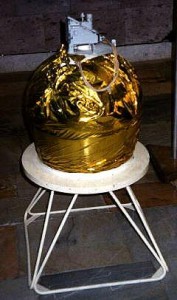
But both suffered systems failures with Phobos-1 losing communication after an Earth ground station technician uploaded a software command that deactivated the control thrusters providing attitude-control. Phobos-2 entered Mars orbit in January of 1989 but spacecraft contact failed in late March when the spacecraft was to approach within 50 meters of the moon to release its two landers. An on board computer system failure was the probable cause for signal loss.
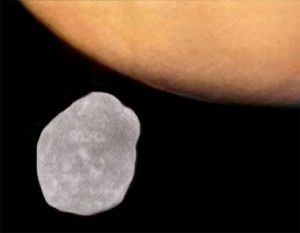
The fall of the Soviet Union gutted the space exploration budget and it wasn’t until 1996 before Russia tried to pick up where Phobos had failed. The mission was named Mars 96 and included an orbiter packing 20 scientific experiments, multiple landers and surface penetrators. The landers and penetrators were designed to survive a one Martian year (687 Earth days) mission. The landers included magnetometers, seismometers and panoramic cameras. Launched by a Proton rocket Mars 96 never reached Earth orbit. This marked the first and last attempt by Russia to continue the 20th century exploration of Mars. They would try again in 2011 and experience similar failure with Phobos-Grunt.
The United States Returns to Mars in the 1990s with New Missions – Three Failures and Two Successes
Almost seventeen years after Viking, the Americans launched Mars Observer in September 1992. Mars Observer was designed based on Earth orbiters and included cameras and laser altimeters to image and map the topography of the entire planet. The outward journey took eleven months with no problems until three days before the spacecraft was to go into orbit when a command to pressurize the propulsion system caused something catastrophic to occur. All communication was lost. In analyzing the spacecraft telemetry NASA scientists and engineers concluded that ruptured tubing in the propulsion system caused a fatal spin. No one had accounted for the interplanetary conditions that caused nitrogen tetroxide to leak into the fuel lines resulting in an explosion.
A new mission four years later, Mars Global Surveyor, used a radically altered design producing a spacecraft that achieved stellar results. Operating for nearly ten years, Mars Global Surveyor’s cameras took more than 250,000 images. It sent back more than 5 terabits of data orbiting the planet twelve times per day from pole to pole. MOLA, the Mars Orbiter Laser Altimeter, measured the topography of the planet surface creating an accurate elevation map precise to within 30 centimeters (1 foot). A thermal emission spectrometer studied the atmosphere and the mineral composition of the Martian surface. The electron reflectometer showed that Mars magnetic field was not globally generated but localized to particular areas of the planet. A gravity field experiment used telecommunications equipment to map variations in Mars’ gravity fields.
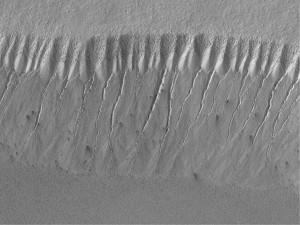
Mars Global Surveyor provided us with evidence of water the surface of Mars, not just in the past, but in the present, and once again changed our perception of whether the planet could have or currently supports life.
A second mission launched in 1996 called Mars Pathfinder was built on a slim budget and demonstrated new lander design technology. The former team that had built Viking was no longer around to help desgin a landing entry system on the cheap. With one-fifth the budget of Viking the Americans borrowed a Soviet idea deploying a system of airbags as landing cushions, something that had been used for Luna missions. They also planned the mission for a direct entry rather than a descent from orbit.
In addition to the lander Mars Pathfinder deployed a small rover, Sojourner, the first mobile observation station to deploy on Mars. The design team recognized that the Martian surface would provide significant hazards and built the chassis and wheels using six wheels mounted on a rocker-bogie suspension. The top of Sojourner served as a solar collector to provide power to the package of experiments and wheels.
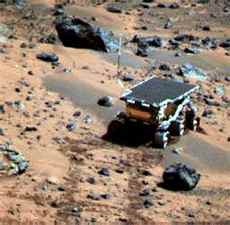
On July 4, 1997, Mars Pathfinder landed on the planet bouncing 16 times and as high as 15 meters (50 feet) before coming to rest. Sojourner deployed from the lander to take pictures and study the chemical composition of nearby rocks. Designed to operate for one month on the surface, the lander and rover operated for 83 Martian days sending back a wealth of data and images, some of them showing rocks that appeared to have been shaped by running water.
The next mission to the red planet, the Mars Climate Orbiter was a weather satellite designed to orbit Mars. Part of a dual launch mission to arrive at Mars in the fall of 1999, it included a second spacecraft, the Mars Polar Lander, the latter designed to study the Martian polar ice cap. The lander was dependent on Mars Climate Orbiter to provide communications with Earth ground stations. Both missions ended in failure when communication with the orbiter was lost shortly before orbital insertion. The cause of the failure, the joint development team that included British and American scientists had failed to catch a fundamental mathematical mistake, converting Imperial units to Metric. The orbiter burned up in the Martian atmosphere and the Polar Lander following it had no means to communicate back to Earth when it arrived three months later. It was an expensive mistake.
The Americans would try again but not in the 20th century.
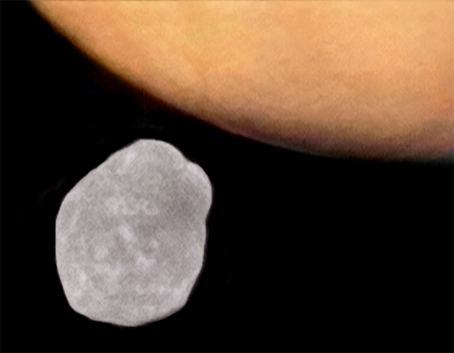








My dad was the NASA inventor of the ballute system (the type of parachute) that landed the two Viking Landers on Mars. The Mars missions were NOT discontinued because they didn’t find ‘life on Mars.’ That is a stupid myth.
They found life, and the reports show that.
Richard M. Nixon, facing exponential growth in paying deficits run up by the Vietnam War ended the priority of deep space missions (Mars included). The hawks were concerned we “might lose” in Vietnam, and so they threw money at that problem.
Nixon saw the drive into space as a Democrat program. He saw it as something that glorified the Kennedy name (and he felt he wold run against a Kennedy – again … and he didn’t want to lose, as JFK’s victory left a bad taste in his mouth). The Nixon Administration made massive cuts in the mid-70’s to pay for the Vietnam War. That is the real truth.